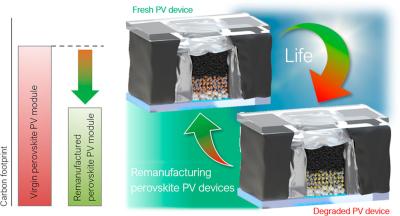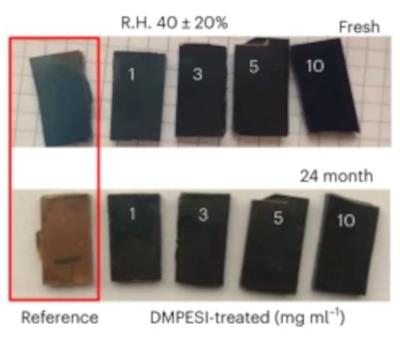![]() EPFL is a Switzerland-based technical university and research center. EPFL is focuses on three missions: teaching, research and technology transfer. EPFL works together with an extensive network of partners including other universities and institutes of technology, secondary schools and colleges, industry and economy, political circles and the general public.
EPFL is a Switzerland-based technical university and research center. EPFL is focuses on three missions: teaching, research and technology transfer. EPFL works together with an extensive network of partners including other universities and institutes of technology, secondary schools and colleges, industry and economy, political circles and the general public.
EPFL does extensive perovskite R&D work and is responsible for many publications and advancements in the field.
Route Cantonale
1015 Lausanne
Switzerland
The latest EPFL perovskite news:
Researchers use dopant-additive synergism to develop perovskite solar module with efficiency of 23.3%
Researchers from EPFL, Soochow University, Chinese Academy of Sciences, Lomonosov Moscow State University, Luxembourg Institute of Science and Technology (LIST), Julius Maximilian University of Würzburg, Toin University of Yokohama, Southern University of Science and Technology, Xi’an Jiaotong University, North China Electric Power University and Toyota Motor Europe recently developed a solar panel relying on EPFL's record-breaking 25.32%-efficient 2D/3D perovskite solar cells unveiled in July 2023.
The group's research demonstrates a larger surface area of 27.22 cm2, achieving an impressive efficiency of 23.3%. In the paper, the scientists explain that the module's high efficiency was achieved thanks to a synergistic dopant-additive combination strategy aimed to improve the cell absorber's uniformity and crystallinity. They used, in particular, methylammonium chloride (MACl) as a dopant and a Lewis-basic ionic liquid known as 1,3-bis(cyanomethyl)imidazolium chloride ([Bcmim]Cl) as an additive.
Researchers develop method for re-manufacturing perovskite solar cells and modules
An international group o researchers, including ones from the Fraunhofer Institute for Solar Energy Systems ISE, Solaronix, University of Cambridge, École Polytechnique Fédérale de Lausanne (EPFL) and others, have developed a method to re-manufacture fully encapsulated perovskite solar cells after recycling. According to the researchers, the re-manufactured devices can achieve 88% of their original efficiency.
The novel method for re-manufacturing perovskite solar cells (PSCs) uses carbon-based electrodes (CPSMs). Re- manufacturing, as opposed to merely recycling, is described as the combination of re-used, recycled, repaired, or replaced parts to make a new product. “In this work, we demonstrate for the first time a re-manufacturing strategy for glass-glass encapsulated perovskite solar cells,” the scientists stated. “Our study presents a facile experimental method to remove the edge-sealant, encapsulant, back electrode, and degraded perovskite, allowing reuse of the device constituents.”
Researchers use crown ethers to simultaneously prevent lead leakage and moisture degradation
Researchers at Korea's Pusan National University, Kyungpook National University, Switzerland's École Polytechnique Fédérale de Lausanne (EPFL) and University of Fribourg have pioneered an approach that not only rectifies lead leakage but also focuses on interfacial passivation. The team used the method to achieve perovskite solar cells with 21.7% power conversion energy.
The presence of lead ions in perovskite solar cells not only causes lead leakage, which is hazardous to the environment, but in the presence of moisture, the perovskite tends to degrade. Multiple approaches have been suggested to resolve this issue, including encapsulating the device and compositional engineering of the perovskite light absorbers. The crown ether was found to assist in resisting degradation due to moisture for 300 hours at room temperature and 85 percent humidity. In the study, the researchers tested many crown ethers, but found that B18C6 was the best for interfacial passivation.
Spotlight on the DIAMOND EU project
The DIAMOND project aims at developing ultra-stable, highly-efficient and low-cost perovskite photovoltaics with minimized environmental impact, promising stabilities far beyond all previous achievements of photovoltaic solar cells.
It was launched in October 5th, 2022, and is planned to continue until November 30th, 2025.
Researchers use liquid crystals to advance PSC commercialization
A research team, led by Northwestern scientists, has developed a method that could moves perovskite solar cells closer to industry adoption and widespread use. Using liquid crystals that can respond to temperature change and avoid accumulating precipitation, the group enabled the protection of large-area perovskite films.
This approach led to a 22% efficiency and a stabilized efficiency of 21% for solar modules with enhanced damp heat (85% relative humidity at 85 degrees Celsius) stability and a size of 31 sq. centimeters.
Project P4SPACE to advance development of perovskite photovoltaics for space environment
The EU-funded P4SPACE project started in April 2023 and will run until the end of March 2025.
The project will develop and scale-up PSCs with high performance and durability in harsh space environments. It will aim to deliver sustainable PV technology for any present and future space environment application.
Researchers report sulfonium-based treatment for perovskite films that yields extremely stable perovskite solar cells
A collaborative team of researchers, including ones from Uppsala University, CNR-SCITEC, Fraunhofer ISE, University of Cambridge, Empa, EPFL and additional institutes, recently introduced an unexplored dimethylphenethylsulfonium iodide (DMPESI) molecule to post-treat formamidinium lead iodide perovskite films. The treated films showed outstanding stability upon light soaking and remarkably remains in black-phase after 2 years ageing under ambient condition without encapsulation.
Fresh and 24-month aged unencapsulated perovskite film (1.0 cm by 2.0 cm) without and with DMPESI treatment of different concentrations. Image from Nature Energy
The DMPESI-treated PSCs deliver a breakthrough record in operational stability of highly-efficient PSCs with less than 1% performance loss after more than 4500 h at maximum power point tracking, yielding an extraordinarily high theoretical T80 of over 9 years under continuous 1-sun illumination, which would correspond to a photon flux of an outdoor PV installation in Sweden or Germany (1,000 kWh m−2 per year) of over 78 years.
Researchers use hole-selective contact on light-managing textured substrates for efficient and stable inverted PSCs
Inverted perovskite solar cells (PSCs) can deliver enhanced operating stability compared to their 'normal'-structure counterparts. To improve efficiency further, it is vital to combine effective light management with low interfacial losses. Now, scientists at Northwestern University, University of Kentucky, North Carolina State University, University of Toronto, Ecole Polytechnique Fédérale de Lausanne (EPFL) and Peking University have developed a conformal self-assembled monolayer (SAM) as the hole-selective contact on light-managing textured substrates.
The team reported that molecular dynamics simulations indicate cluster formation during phosphonic acid adsorption leads to incomplete SAM coverage. They devised a co-adsorbent strategy that disassembles high-order clusters, thus homogenizing the distribution of phosphonic acid molecules, thereby minimizing interfacial recombination and improving electronic structures.
Researchers design 2D/3D perovskite solar cell with efficiency of 25.32%
Researchers from Switzerland's Ecole Polytechnique Fédérale de Lausanne (EPFL), Chinese Academy of Sciences (CAS) and Peking University have developed a perovskite solar cell with a 2D/3D heterojunction architecture.
The cell uses a 2D perovskite layer at the interface between the perovskite and the hole transport layer, which the researchers said can improve charge-carrier transport/extraction while suppressing ion migration. Cells with this architecture usually exhibit large exciton binding energies and are generally more stable than conventional 3D devices due to the protection provided by the organic ligands.
Researchers develop new surface coating that helps improve the stability of perovskite solar cells
Researchers from the University of Toronto, the University of Kentucky, EPFL, North Carolina State University and Northwestern University have designed a perovskite solar cell that can stand up to high temperatures for more than 1,500 hours — an important achievement on the to commercialization.
“Perovskite solar cells offer new pathways to overcome some of the efficiency limitations of silicon-based technology, which is the industrial standard today,” said Ted Sargent, professor of electrical and computer engineering at the McCormick School of Engineering, professor of chemistry in the Weinberg College of Arts and Sciences, and a former professor at the University of Toronto. “But due to its multi-decade head start, silicon still has an advantage in some areas, including stability. This study shows how we can close that gap.”
Pagination
- Page 1
- Next page



